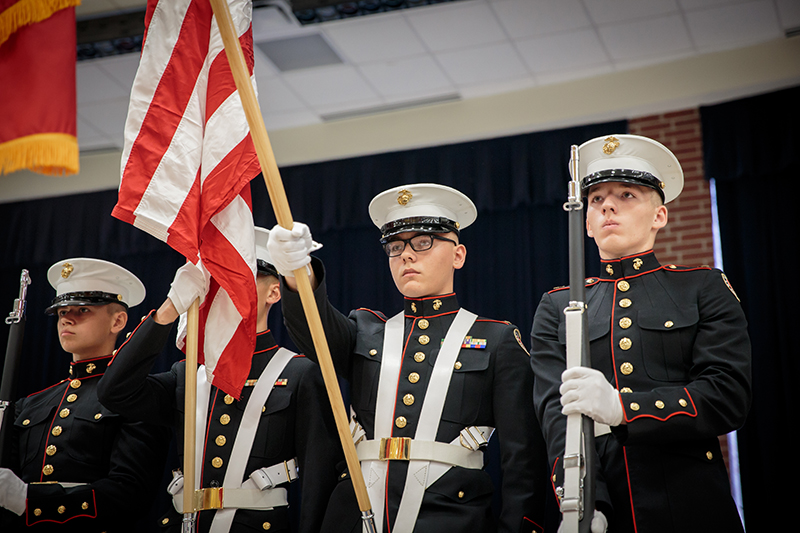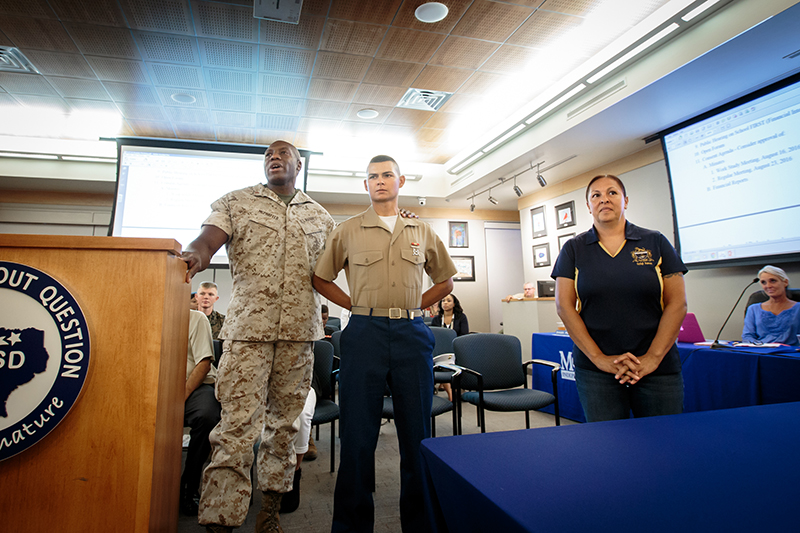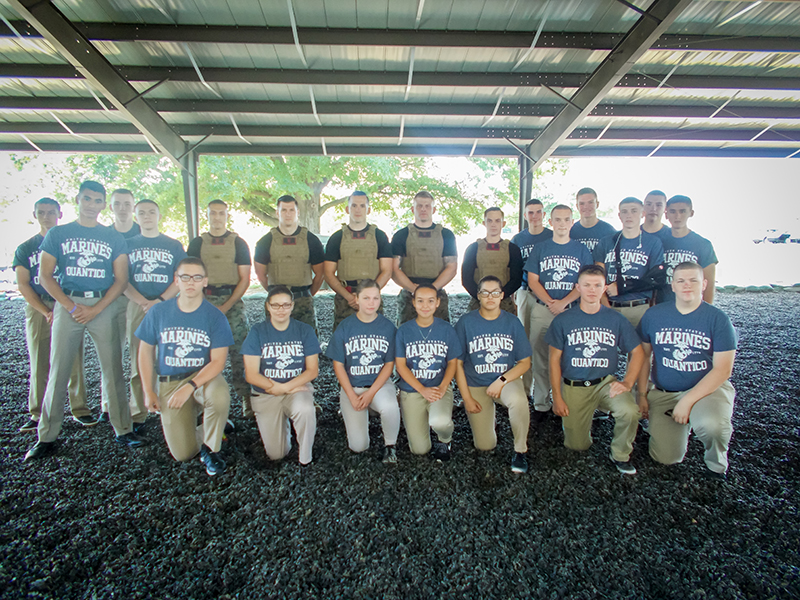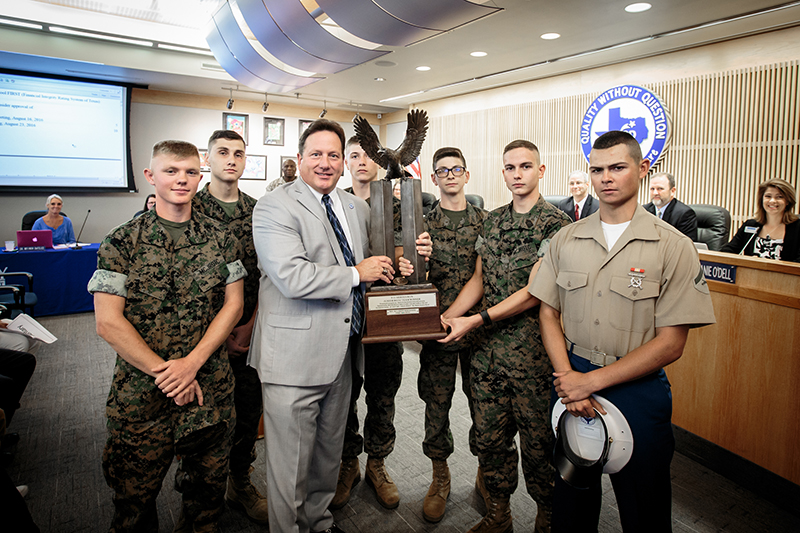McKinney High School Marine Corps JROTC Prepares Students to Lead
McKinney, Texas – When you hear the title United States Marine Corps Drill Instructor, Ron McPhatter may be what you envision. The hulking frame of this retired Marine Corps Chief Warrant Officer looms over ordinary sized people. And, when he walks into a room, it seems to fill up with his presence.
When he issues commands to the cadets of the McKinney High School Marine Corps Junior ROTC (MCJROTC) unit that he leads with Gunnery Sergeant (Ret) Trish Ramos, they are generally received with a very strong urge to comply in a timely and orderly fashion.

Cadets of the MHS MCJROTC present the colors at an MISD event.
And, although she is not as physically imposing as McPhatter, Ramos’ presence in the room is no less commanding and is just as intimidating. She is a United States Marine, and she doesn’t mess around.
McPhatter (known to his cadets and colleagues as Gunner) and Ramos (who goes by Gunny) have led the MHS MCJROTC program since its inception in 2014. Since then, between 90–145 cadets have participated in the program each year.
McPhatter and Ramos have spent a good portion of their lives serving their country in the Marine Corps, and although the setting has changed, the work they currently perform continues to serve the greater community. They are extremely proud to bear the title of United States Marine, and their work with the Marine Corps JROTC program at MHS reflects it.
Last week, McPhatter and Ramos were kind enough to sit down and talk about the program.
MISD: First, can you tell us a little about your service in the U.S. Marine Corps and how you came to be involved with the MCJROTC program at MHS?
Ramos: I was on active duty for 20 years. I started out on Parris Island as a recruit. My first duty station was Hawaii. I spent three years there, left Hawaii and went to Yuma, Arizona. My MOS (Military Occupation Specialty) was 3531, so I was motor transportation—a truck driver, in the simplest terms. I got to Hawaii and drove trucks there, loaded ships, loaded airplanes, did all kinds of different things. I was attached to an air wing unit, so we were constantly moving gear. I went to Yuma, Arizona and picked up another MOS—3534—which is a semi tractor-trailer refueler. I would refuel airplanes, helicopters, stuff like that.
After Yuma, I went to Okinawa, Japan for a year and then went to Parris Island to Drill Instructor School. After, I graduated, I spent three years as a drill instructor at Parris Island and then went back to Okinawa. Initially, I had a one year tour. I went to Iraq, and when I returned, I said, “Well, I want to extend another year,” because the unit I was attached to was redeploying to Iraq again, and I wanted to go out with them.
So, I extended another year in Okinawa and went to Iraq for another tour. As soon as I came back, I went to Camp Pendleton in California and worked two years there until I got volunteered for another tour to Iraq. I went with an artillery unit that time around, which was kind of cool because women, at that time, weren’t allowed in infantry units, artillery units. So, I was one of the very few women that got to deploy to a combat zone with our artillery unit.
After I left there, I put in for an AMOI duty, which is teaching ROTC at the collegiate level, and that’s kind of how I go into JROTC because we would go to ROTC drill competitions, and they started talking about high school JROTC. Prior to retiring from Boston University, I put in a package to get certified as a JROTC instructor. A school was available here in Texas, so I took it and kind of made my way down to McKinney.

CWO-3 (Ret) Ron McPhatter (left) and Gunnery Sgt. (Ret) Trish Ramos (right) introduce former MHS MCJROTC cadet and current active duty Marine Draven Crowley to the MISD Board of Trustees in 2016. Crowley had recently completed recruit training in San Diego and earned the title of Company Honor Graduate.
McPhatter: I was in the Marine Corps for 21 years, 3 months and 15 days on active duty service. My various duty stations were Parris Island as a recruit and as a drill instructor. I have been stationed in North Carolina, South Carolina, Florida, Virginia, California, Northern California, Japan, Korea and a brief exercise in the Philippines.
The most rewarding thing I did in the Marine Corps was to be a drill instructor because you get to make Marines. I did that two years. It’s a pretty demanding tour, stressful, the psychological aspect of it. So, at that time, it was a two year tour, and then to cut down on the cost, they extended it to three years. [Ramos] did three years.
We have a huge generation gap between us because she wasn’t even a Marine yet when I was making Marines. But, we both made Marines as drill instructors, and I got into JROTC because it’s a way to continue to make an indelible imprint on the youth of America with a Marine Corps spin to it. I tell all my students that my goal is to make them better than I was when I was graduating high school. “You’re supposed to be starting off better than I did.” So, that’s our goal.
MISD: How long is the MCJROTC program, and how do students join?
McPhatter: A student can be in the program for four years if they elect to. We have students right now who are in their fourth year of JROTC. We tell the students that it’s a year long program broken up into two semesters. They start off as a Leadership Education, Level 1 and progress through each successive year — 1, 2, 3 and 4. We have an application process to make sure that students coming into the program want to be in the program and that they’re a good fit for the program. That way everyone is learning cohesively together, and we don’t have a bunch of individuals. We’re focusing on teamwork.
MISD: What does a cadet’s MCJROTC schedule look like?
McPhatter: The daily schedule is Monday and Tuesdays in the classroom. Wednesday is physical fitness day. Thursday is a uniform inspection day, so they will be dressed in uniform, and they’ll conduct a uniform inspection. On Fridays, it would be another physical fitness day. However, with this being the first week of school, we’re slowly acclimating them to the rigors of JROTC, so we’re teaching them how to prepare their uniforms. We have an abundance of new cadets who don’t know.
Ramos: They’re enthusiastic about it. So, it always helps that we’re not going to have kids that don’t want to be here or forced to be here because then obviously they are not going to be an active participant in the JROTC program. And, rather than excelling, they’re just going to be a hindrance, not only to the program, but to themselves and to the people around them as well.
MISD: Speaking of new cadets…this summer you took some of them to Quantico. Can you tell us about that trip?
McPhatter: The goal of Quantico was to open up our students’ minds to opportunities within the Marine Corps. Quantico is the hub of all Marine Corps officers. Every officer in the Marine Corps has been to Quantico. It’s a rite of passage. Our Officer Candidate School and TBS [The Basic School] are at Quantico, so we took our kids there because our goal is for them to be leaders in the military or leaders in the civilian world.
We took them there, so they could see different aspects of training for the officers that everyone goes through. But, we also took them to the Naval Academy as well because we have kids who are sincerely interested in service academies. We toured the Naval Academy and spent almost an entire day there, and they went over the application process.
We also took them to a parade to see the Silent Drill Platoon perform. The kids had a good time with it. Then, we toured Washington, D.C., so they got to see the historical perspective of our country. Then we had a fun day where we took them to a theme park.
Eighteen kids went, and we went with another school to help defray some of the cost. What we found is that our kids…received a lot of compliments. From the bus driver to the tour guides to people passing by who would see our kids would say, “Hey, they are very respectful. You’re doing something great with them.” And, that’s what we want. We want them to feel like they are part of something special.

New MHS MCJROTC cadets visited the Marine base at Quantico this summer. Here they pose with Marines at the Martial Arts Center for Excellence.
MISD: In general, how have students responded to the program?
McPhatter: Last year we went through a little something where I pulled back the reins, and we kind of changed our scope. And, the scope was basically that we were not going to be as intense with our physical fitness and that we would let the cadets develop their leadership a little on their own with supervision from us. But, the cadets, toward the end of the year, said, “It’s not the same. We want to go back to the way it was.” And the way it was—to them—was more intensity.
So, we looked at it, and we actually agreed that we have a different general personality in our program, and these cadets were showing up throughout the summer to our workouts and our training. So, we’re picking up the intensity and going back to what we’re known for. We have a reputation amongst other schools in the area. They know our cadets are disciplined and structured, so we want to stay that way.
MISD: How many of your cadets typically go on to serve in the military?
Ramos: For any given class, we would have between three to six, depending on the class size. Each year varies. Last year, we were at 91 students, so we had about nine graduating. A little less than 10 percent of each graduating class will actually go on to some form of military service.
McPhatter: Our kids have the heart of service. They want to serve, but they may not be qualified. That’s the issue. You’ll see so many kids with the desire to serve, but the numbers are minuscule compared to those that actually make it. Disqualifications could be physical or medical, sometimes academic. The military service is getting tougher about taking applicants. They streamline the process and make it difficult for people to get in so that they’re getting the top candidates.
MISD: Ultimately, what do you want the cadets to take away from their time in the program?
McPhatter: I want them to take away the leadership skills—leadership skills and to be more community aware and selfless. We like to think that we want our kids to be more polished when they graduate high school, that they are capable of being totally independent on their own and can function and win out in a job application or a scholarship application—or whatever it is that they want to do—from having been in this program.
MISD: The unit has won some awards and competitions over the past three years. Can you tell us about some of that?
McPhatter: A big competition for us right now that they’re preparing for is called the Heroes Run, which is a 9/11 run, and it’s to benefit the Travis Manion Foundation. We’ll go down to Dallas, and we’ll race in the 5K. We won that one last year and really won it the first year. We’ll take the trophy back and defend it and bring it back again because that’s what they’re preparing for.
We also compete in military drill type events. We’ve done well at some and, by my standards and by her standards, not so well at others. What we want our kids to take away from that is if you’re going to win something, you’re going to have to give a winning ethic, a hard work ethic. We’re trying to instill in them that work ethic that doesn’t just happen here in JROTC, but it corresponds to your core English class or your math class or the job that you’re on. If you want it, you have to work for it.
(Note: The MCJROTC team from MHS went on to win the Heroes Run trophy again this year on Sat., Sept. 9 in Dallas.)

Members of the MHS MCJROTC team present the 2016 Heroes Run trophy to MISD Supt. Dr. Rick McDaniel at a meeting of the MISD Board of Trustees last year.
MISD: When you look at the program you are building, what are you most proud of?
Ramos: I would have to say the quality of students that leave here, whether they’re here for one year or longer. I think just the quality of students and everything that we’ve accomplished up until this point. I like to say we have a very successful JROTC program compared to a lot of other schools that maybe have been around for a very long time—not only because we implement a certain standard, but the cadets like that standard. They want to be held accountable. They want to be held to a certain level. They love representing McKinney High School, McKinney JROTC and just being a part of something bigger than themselves.
We get a lot of students that come back, and we love seeing the kids come back wanting more and really enjoying this program and this kind of environment. To me, that just shows that they’re going to leave here as much better people than they were when they came here originally.
MISD: Do you get a sense from the students that, since this is a Marine Corps JROTC program, they view it as better than other JROTC programs?
McPhatter: Yes, and part of that is due to the instructors. We pass on the fact that you’re a Marine Corps JROTC. You’re held to a different standard than the others, and when we go out and compete, you’ll see the difference between yourselves and the others. We want them to see that.
We tell them that when they wear this uniform, sometimes they will be misconstrued as Marines. People will come up to them and say, “Thank you for your service,” and they haven’t served. But, when that happens, we tell them how to properly handle it. Just say, “Thank you,” and continue on with what you’re doing. When that happens, it makes me feel good because people think that they’re Marines, and you know, we tell them, “If you’re going to wear it, you need to represent it.”
But, yeah, we do think our kids feel a certain amount of pride being in this program, and that’s good because when they graduate from here, I want them to feel like they accomplished something, and they were a part of a family oriented group.
Kids who have graduated from here still keep in touch with us. I’ll get messages about, “Sir, this leadership situation — how should I handle it?” We had a kid graduate number one out of 700 kids, and we had another one graduate number one out of more than 50 in his platoon. We have a student at West Point. We have a student at the Air Force Academy. We have a student at Baylor University on a scholarship.
Ramos: We have another one at the University of Michigan on an ROTC scholarship.
McPhatter: And, the University of Arkansas as well.
We want our kids to be focused and moving forward—progressively moving forward. If they want to serve, we’re here to help them. If they say, “Sir, I don’t want to go into the military, I say, “Fine. I’m still going to teach you the leadership skills you need to make yourself competitive in the civilian market.”
Some programs just exist to exist, and we don’t want that. That will never be us.
Need Help?
If you need additional assistance with the content on this page, please contact MISD Communications Department team member Shane Mauldin by phone at 469-302-4007 or by email here .